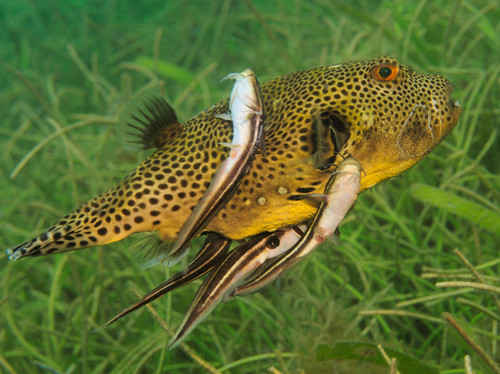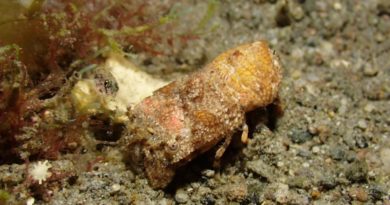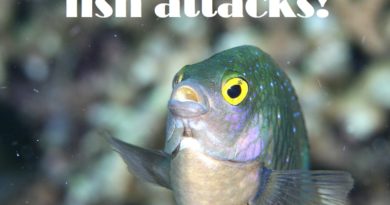Catfish Cooperative Kamikaze Defense?
Recently, on a dive off Negros Island in the Philippines, I observed a very strange situation. A star puffer, Arothron stellatus, had four striped catfish, Plotosus lineatus, stuck to itself. The catfish were dead or severely stressed, and could seemingly not get off the puffer fish, their spines were embedded so deeply into it. The puffer was swimming over a seagrass meadow, at what semed to be a normal speed for these fish. This is how the odd fish-pile looked:
I also got a bit of video of the situation:
This is a school of the same species of catfish, filmed on a previous dive:
I am speculating that the puffer fish attempted to prey on a school catfish, and that the 4 catfish got stuck on it during that hostile encounter.
This observation is anecdotal, I have only seen this once in over a thousand dives in the Philippines. How much this situation is due to an accidental, random event, and how much due to adaptive defensive behavior by the catfish I can’t say for sure, obviously. Hence, I am doing a good amount of speculation here. But hey, this is a blog post and not a paper, and it’s ok to speculate if one says that this is what one does. The question which came to my mind is:
Why would the catfish sacrifice themselves in such a way to deter predation on their school?
Let’s look at Hamilton‘s rule (here and here are tow papers of mine concerning that rule), a rule often used to explain altruistic behavior:
c < r b
This means that the cost of an altruistic act must be smaller than the benefit of the act to others multiplied by the relatedness of the animal acting altuistrically to the beneficiaries. The classic example is that a soldier would throw himself onto a hand-grenade to save three of his brothers. Each brother statistically shares half of his genes with him, hence the relatedness is 0.5 x 3; the benefit in each case is 1 (life saved versus died). The cost for the soldier who sacrifices himself is 1 (life lost), and
c < r b
1 < 1.5 x 1
hence from a purely genetic point of view the altruistic act makes sense. The soldier, by blocking the grenade blast, made sure more of his genes make it to the next generation than otherwise.
The fact that 4 catfish died, or nearly died does not make sense in this regard at first sight. The puffer fish would most likely have caught only one catfish, and four of them lost their lifes to counter that attack? To look at it in the context of Hamilton’s rule, we get:
c < r b … is it?
4 < 1 x 1 This certainly does not work out…
Can this observation be better interpreted by proposing that the 4 catfish sacrificed themselves for the whole school of catfish? The death of 4 individuals would certainly make sense to save the lifes of 100+ closely related catfish. That any attack on the school is understood by the catfish as an attack on every single fish? Is this altrusitic behavior on a group level (the fish school) – even though in this case the puffer might have just snatched one catfish? What does this strange behavior tell us about the relatedness of catfish in one school? How closely related would they have to be for this sacrifice to make sense?
The discussion of group selection is one with a lengthy history, and with some hard-nosed exchanges (see this widely discussed paper and some context here). Is Hamilton’s rule merely an emergent result of more basic biological principles in some cases of altruism, or is genetic calculus like the one expressed in Hamilton’s rule actually guiding animal behavior?
In the context of this theoretical dispute, it’s worthwhile to keep one’s eye open for unusual examples of altrusitic behavior in the field. Again, let me stress I am speculating, and I don’t know how much of a freak accident this situation was, but these are intriguing questions to me, and catfish group defense behavior might be something to look more closely at.



